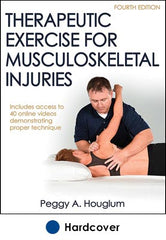Using Therapeutic Exercise Before Orthopedic Surgery
This is an excerpt from Therapeutic Exercise for Musculoskeletal Injuries 4th Edition With Online Video by Peggy Houglum.
Prehabilitation is the use of therapeutic exercises in advance of a surgical procedure to improve the functional capacity of the patient so that the patient may withstand the effects of inactivity after an orthopedic surgery. It has been demonstrated that patients who perform preoperative exercises do better postoperatively in both short-term and long-term results. Not all patients have the opportunity to perform preoperative therapeutic exercises prior to surgery, but whenever possible, it is advisable.
It is well known and accepted that, in addition to the inflammatory healing effects (pain, swelling, and muscle spasm) that follow surgery, motion and strength deficits also result. Whatever strength level the patient has at the time of surgery is reduced after surgery; it makes intuitive sense, then, that the more strength a patient has prior to surgery, the more strength she will have immediately after surgery. For example, if patient A has quadriceps strength that allows him to lift 30 lb with his knee extensors, and patient B, who has an equivalent injury to patient A, has quadriceps strength that allows him to lift 50 lb with his knee extensors preoperatively, after each of them undergoes the same surgery, they will each lose 20 lb of strength. Postoperatively, patient A can now lift 10 lb and patient B can now lift 30 lb (figure 1.3).
Example of differences in preoperative and postoperative strength measures between two similar patients. The stronger a patient is before surgery, the stronger a patient is after surgery.
Studies have demonstrated that patients undergoing prehabilitation not only recover from surgery better but their strength gains are more rapid after surgery, and they have less postoperative pain. Preoperative rehabilitation exercises include many of the same exercises used in postoperative rehabilitation. The use of neuromuscular electrical stimulation has shown beneficial effects in preoperative strength gains. Efforts to optimize range of motion and soft tissue mobility along with gains in strength and function are also part of the prehabilitation program. Treatments should stay within the patient's pain tolerance and should not further aggravate the existing condition.
In addition to optimizing the patient's physical abilities prior to surgery, prehabilitation has other benefits. This is a time when the rehabilitation clinician can explain to the patient both the surgical procedure and the postoperative program he or she will undergo. These explanations can go a long way toward relieving the patient of anxiety and apprehensions that are natural prior to major surgery. Preoperative instructions are also provided during this time. For example, if the patient is to wear a postoperative brace, instructions on donning and removing the brace can be provided with practice time for the patient so it becomes an easy task after surgery. Gait training instructions if crutches or other assistive devices will be used postoperatively are also provided during this time; again, practicing these techniques will enable the patient to perform ambulation with the assistive devices more easily after surgery.
Since therapeutic exercises in prehabilitation programs and rehabilitation programs are essentially the same, specific delineation of prehabilitation programs is not made in this text. Keep in mind, however, that whenever possible, preoperative exercises should be a part of the overall surgical treatment plan.
Learn more about Therapeutic Exercise for Musculoskeletal Injuries 4th Edition With Online Video.
More Excerpts From Therapeutic Exercise for Musculoskeletal Injuries 4th Edition With Online Video

Get the latest insights with regular newsletters, plus periodic product information and special insider offers.
JOIN NOW


